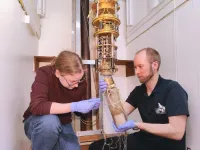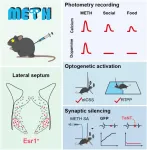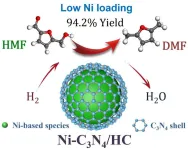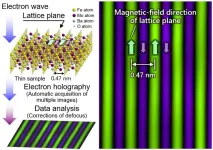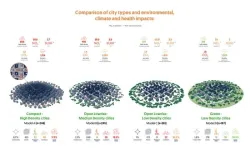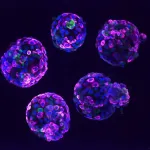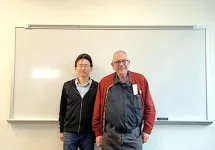(Press-News.org) One of the greatest mysteries of science could be one step closer to being solved.
Approximately 80% of the matter in the universe is dark, meaning that it cannot be seen. In fact, dark matter is passing through us constantly – possibly at a rate of trillions of particles per second.
We know it exists because we can see the effects of its gravity, but experiments to date have so far failed to detect it.
Taking advantage of the most advanced quantum technologies, scientists from Lancaster University, the University of Oxford, and Royal Holloway, University of London are building the most sensitive dark matter detectors to date.
Their public exhibit entitled “A Quantum View of the Invisible Universe” is showcased at this year’s Royal Society’s flagship Summer Science Exhibition from 2-7 July 2024.
The researchers include Dr Michael Thompson, Professor Edward Laird, Dr Dmitry Zmeev and Dr Samuli Autti from Lancaster, Professor Jocelyn Monroe from Oxford and Professor Andrew Casey from RHUL.
EPSRC Fellow Dr Autti said: “We are using quantum technologies at ultra-low temperatures to build the most sensitive detectors to date. The goal is to observe this mysterious matter directly in the laboratory and solve one of the greatest enigmas in science.”
There is indirect observational evidence of the typical dark matter density in the galaxy, but the mass of the constituent particles and their possible interactions with ordinary atoms are unknown.
Particle physics theory suggests two likely dark matter candidates: new particles with interactions so weak we haven’t observed them yet, and, very light wave-like particles termed axions. The team are building two experiments, one to search for each.
Of the two candidates, new particles with ultra-weak interactions could be detected through their collisions with ordinary matter. However, whether these collisions can be identified in an experiment depends on the mass of the dark matter being searched for. Most searches so far would be able to detect dark matter particles weighing between five and 1,000 times more than a hydrogen atom, but it is possible that much lighter dark matter candidates may have been missed.
The Quantum Enhanced Superfluid Technologies for Dark Matter and Cosmology (QUEST-DMC) team aims to reach world-leading sensitivity to collisions with dark matter candidates with mass between 0.01 to a few hydrogen atoms. To achieve this, the detector is made of superfluid helium-3, cooled into a macroscopic quantum state and instrumented with superconducting quantum amplifiers. Combining these two quantum technologies creates the sensitivity to measure extremely weak signatures of dark matter collisions.
By contrast, if dark matter is made from axions, they will be extremely light – more than a billion times lighter than a hydrogen atom – but correspondingly more abundant. Scientists would not be able to detect collisions with axions, but they can search instead for another signature - an electrical signal that results when axions decay in a magnetic field. This effect can only be measured using an exquisitely sensitive amplifier that works at the highest precision allowed by quantum mechanics. The Quantum Sensors for the Hidden Sector (QSHS) team is therefore developing a new class of quantum amplifier that is perfectly suited to search for an axion signal.
The stand at this year’s exhibition will enable visitors to observe the unseeable with imaginative hands-on exhibits for all ages.
Demonstrating how we infer dark matter from observing galaxies, there will be a gyroscope-in-a-box that moves in surprising ways due to the unseen angular momentum. There will also be glass marbles that are transparent in liquid, showing how invisible masses may be observed using clever experimentation.
A light-up dilution refrigerator will demonstrate how the team achieve ultra-low temperatures, and a model dark matter particle collision detector will show how our Universe would behave if dark matter behaved like normal matter.
Visitors can then search for dark matter with a model axion detector by scanning the frequency of a radio receiver, and they can also create their own parametric amplifier using a pendulum.
Cosmologist Carlos Frenk, Fellow of the Royal Society and Chair of the Public Engagement Committee, said: “Science is vital in helping us understand the world we live in – past, present and future. I urge visitors of all ages to come along with an open mind, curiosity and enthusiasm and celebrate incredible scientific achievements that are benefiting us all.”
The research in this exhibit is supported by the UKRI Quantum Technologies for Fundamental Physics programme.
END
Searching for dark matter with the coldest quantum detectors in the world
2024-07-04
ELSE PRESS RELEASES FROM THIS DATE:
UNSW Sydney's Dr Vaishnavi Ananthanarayanan receives RMS Award for Life Sciences
2024-07-04
This accolade highlights her pioneering research in the use of a diverse array of advanced microscopy techniques to uncover fundamental biophysical processes.
Currently holding a prestigious EMBL (European Molecular Biology Laboratory) Australia Group Leader fellowship, Dr Ananthanarayanan leads one of the largest and most dynamic research group in the EMBL Australia Node in Single Molecule Science, based in the Department of Molecular Medicine in the School of Biomedical Sciences.
Her research, which focuses on motor proteins and cytoskeleton dynamics, has set new standards ...
Researchers unveils a critical role of the lateral septum in drug addiction
2024-07-04
Recently, a research team led by Dr. ZHU Yingjie from the Shenzhen Institute of Advanced Technology, Chinese Academy of Sciences has published a study in Neuron, the study presents a comprehensive transcriptional profile of the lateral septum (LS) at the single-cell level, elucidating the spatial distribution of its major neuronal types. The study shows that neurons expressing estrogen receptor 1 (LSEsr1), predominantly located in the ventral subregion of LS, play a crucial role in reward-seeking and methamphetamine (METH) addiction.
In 1954, psychologists Olds and Milner discovered the brain's reward system through intracranial ...
Efficient hydrogenolysis of 5-hydroxymethylfurfural over Ni-C3N4 catalysts
2024-07-04
Utilization of biomass as the basic feedstock for the production and chemicals and energy storage has been demonstrated to be an important alternative to achieve sustainable society, which has attracted increasing interests in both academic and industrial communities for decades. 5-hydroxymethylfurfural (HMF), one of the most important bio-based platform compounds, could serve as a bridge feedstock between biomass resources and chemicals. It is possible to synthesize a series of high-value added chemicals from HMF through hydrogenation, ...
Hitachi’s holography electron microscope attains unprecedented resolution
2024-07-04
Tokyo, Japan—A research team from Japan, including scientists from Hitachi, Ltd. (TSE 6501, Hitachi), Kyushu University, RIKEN, and HREM Research Inc. (HREM), has achieved a major breakthrough in the observation of magnetic fields at unimaginably small scales. In collaboration with National Institute of Advanced Industrial Science and Technology (AIST) and the National Institute for Materials Science (NIMS), the team used Hitachi’s atomic-resolution holography electron microscope—with a newly developed image acquisition technology and defocus correction algorithms—to visualize ...
An innovative test to diagnose chagas disease in newborns
2024-07-04
An innovative test that combines a DNA extraction system inspired by a modified 3D printer (PrintrLab) with loop-mediated isothermal molecular amplification (LAMP) could be used to detect T. cruzi infection -responsible for Chagas disease- in newborns. This is the conclusion of a proof-of-concept study conducted in the Bolivian Chaco, an endemic area for Chagas disease. The study was coordinated by the Barcelona Institute for Global Health (ISGlobal), a centre supported by "la Caixa" ...
Compact cities have lower carbon emissions, but poorer air quality, less green space and higher mortality rates
2024-07-04
What types of cities exist in Europe and which are more favourable in terms of human health, environmental quality and carbon footprint? To answer these questions, a study led by the Barcelona Institute for Global Health (ISGlobal), a centre supported by the "la Caixa" Foundation, has analysed 919 European cities. The research, published in The Lancet Planetary Health, identified four basic urban configurations on the continent: compact-high density cities, open lowrise-medium density cities, open lowrise-low density cities and green-low density cities. The results show that greener and less densely populated ...
Cuts to processed meat intake bring a range of health benefits
2024-07-04
Reducing consumption of processed meat by around one-third could prevent more than 350,000 cases of diabetes in the US over 10 years, a study suggests.
Cutting US adults’ processed meat intake by 30 per cent – the equivalent of around 10 slices of bacon a week – would also lead to tens of thousands of fewer cases of cardiovascular disease and colorectal cancer, researchers say.
A team from the University of Edinburgh’s Global Academy of Agriculture and Food Systems together with the University of North Carolina, Chapel Hill, has developed ...
Pioneering Code of Practice released for use of stem cell-based embryo models in research
2024-07-04
Stem cell-based embryo models (SCBEMs) are three-dimensional biological structures that mimic aspects of early human embryo development. They can be created in the lab from stem cells, and can provide new insights into critical stages of early human development that are normally inaccessible to researchers.
Embryo model work is expected to lead to new interventions for a range of conditions, including revolutionising treatments for recurrent miscarriage, understanding developmental disorders and improving the success rate of IVF.
Although embryo models are not the same ...
First study to measure toxic metals in tampons shows arsenic and lead, among other contaminants
2024-07-04
Tampons from several brands that potentially millions of people use each month can contain toxic metals like lead, arsenic, and cadmium, a new study led by a UC Berkeley researcher has found.
Tampons are of particular concern as a potential source of exposure to chemicals, including metals, because the skin of the vagina has a higher potential for chemical absorption than skin elsewhere on the body. In addition, the products are used by a large percentage of the population on a monthly basis—50-80% of those who menstruate use tampons—for several hours at a time.
“Despite this large potential for public health concern, very little research ...
Rice researchers uncover key mechanisms in chromosome structure development
2024-07-03
Researchers at Rice University are making strides in understanding how chromosome structures change throughout the cell’s life cycle. Their study on motorized processes that actively influence the organization of chromosomes was published in the Proceedings of the National Academy of Science.
“This research provides a deeper understanding of how motorized processes shape chromosome structures and influence cellular functions,” said Peter Wolynes, study co-author and the D.R. Bullard-Welch Foundation Professor of Science. ...
